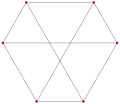 This complex polygon has 8 edges (complex lines), labeled as a..h, and 16 vertices. Four vertices lie in each edge and two edges intersect at each vertex. In the left image, the outlined squares are not elements of the polytope but are included merely to help identify vertices lying in the same complex line. The octagonal perimeter of the left image is not an element of the polytope, but it is a petrie polygon. [1] In the middle image, each edge is represented as a real line and the four vertices in each line can be more clearly seen. |  A perspective sketch representing the 16 vertex points as large black dots and the 8 4-edges as bounded squares within each edge. The green path represents the octagonal perimeter of the left hand image. |

In geometry, a regular complex polygon is a generalization of a regular polygon in real space to an analogous structure in a complex Hilbert space, where each real dimension is accompanied by an imaginary one. A regular polygon exists in 2 real dimensions, , while a complex polygon exists in two complex dimensions, , which can be given real representations in 4 dimensions, , which then must be projected down to 2 or 3 real dimensions to be visualized. A complex polygon is generalized as a complex polytope in .
Contents
- Regular complex polygons
- Notations
- Enumeration of regular complex polygons
- Visualizations of regular complex polygons
- Quasiregular polygons
- Notes
- References
A complex polygon may be understood as a collection of complex points, lines, planes, and so on, where every point is the junction of multiple lines, every line of multiple planes, and so on.
The regular complex polygons have been completely characterized, and can be described using a symbolic notation developed by Coxeter.
A regular complex polygon with all 2-edges can be represented by a graph, while forms with k-edges can only be related by hypergraphs. A k-edge can be seen as a set of vertices, with no order implied. They may be drawn with pairwise 2-edges, but this is not structurally accurate.






![p[4]2 subgroups: p=2,3,4...
p[4]2 --> [p], index p
p[4]2 --> p[]xp[], index 2 Rank2 shephard subgroups2 series.png](http://upload.wikimedia.org/wikipedia/commons/thumb/c/c5/Rank2_shephard_subgroups2_series.png/250px-Rank2_shephard_subgroups2_series.png)























































